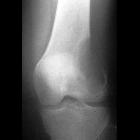Cholesteatom des äußeren Gehörgangs








External auditory canal cholesteatomas (EACCs) are rare, the external auditory canal is an unusual site for cholesteatoma, which are usually in the middle ear or petrous apex.
Epidemiology
The external acoustic canal is a rare location for a cholesteatoma with an estimated incidence of around 1.2 per 1,000 new otological patients. The overall incidence rate in one large study was 0.30 per year per 100,000 inhabitants . For comparison, the annual incidence of middle ear cholesteatoma is around 9.2 per 100,000.
Pathology
A distinction from keratosis obturans has been introduced only in the last few decades. Both mainly consist of epithelial debris in the external acoustic canal. The most useful findings confirming an external auditory canal cholesteatoma are focal osteonecrosis with or without sequestration and lack of epithelial covering of the bony surface . The distinction between keratosis obliterans and cholesteatomas is not merely one of pedantry, but impacts on treatment strategy .
Classification
External auditory canal cholesteatoma can be divided into:
- primary (idiopathic/spontaneous)
- rare
- no antecedent cause identified
- secondary
- more common
- postoperative, postinflammatory, posttraumatic, radiation-induced
A special type of secondary cholesteatoma of the external auditory canal which is worth mentioning separately are those associated with congenital atresia of the external auditory canal.
Radiographic features
Plain radiograph
The Schüller, Stenvers, and Mayer views of the petrous bone have been largely replaced by CT.
CT
High-resolution bone window temporal bone CT is the method of choice to localize the cholesteatoma and to demonstrate bony erosions. They appear as soft tissue attenuating lesions.
MRI
MRI cannot show the early involvement of compact bone. Its role in EACC is not defined.
Treatment and prognosis
Small lesions can be treated endoscopically under local anesthesia, whereas larger lesions need surgery to remove the cholesteatoma and affected bone areas. Grafting of defects may be necessary. Prognosis depends on the extent at the time of diagnosis.
History and etymology
External auditory canal cholesteatomas were first reported by Toynbee in 1850.
Differential diagnosis
General imaging differential considerations include
Siehe auch:
- Cavum tympani
- Cholesterolgranulom der Felsenbeinspitze
- Cholesteatom
- Chordom
- Schwannom
- chronische Otomastoiditis
- Paragangliom
- Chondroblastom
- Riesenzelltumor
- epidermale Inklusionszyste
- erworbenes Cholesteatom
- Metastase
- Histiozytose X
- congenital cholesteatoma
- Primitiver neuroektodermaler Tumor
und weiter:

 Assoziationen und Differentialdiagnosen zu Cholesteatom des äußeren Gehörgangs:
Assoziationen und Differentialdiagnosen zu Cholesteatom des äußeren Gehörgangs:












